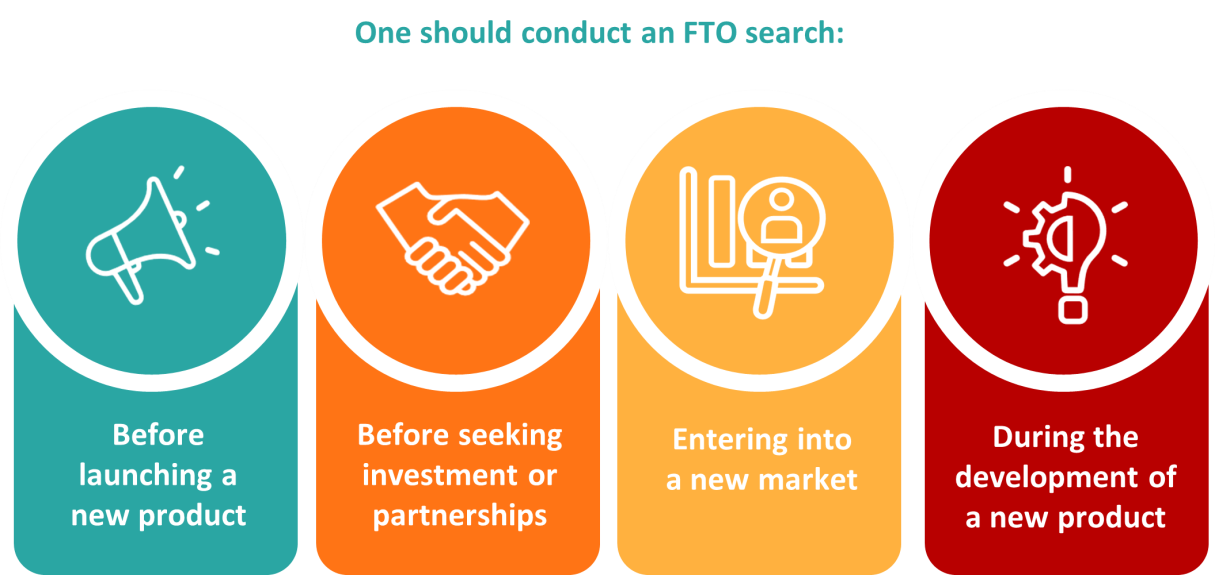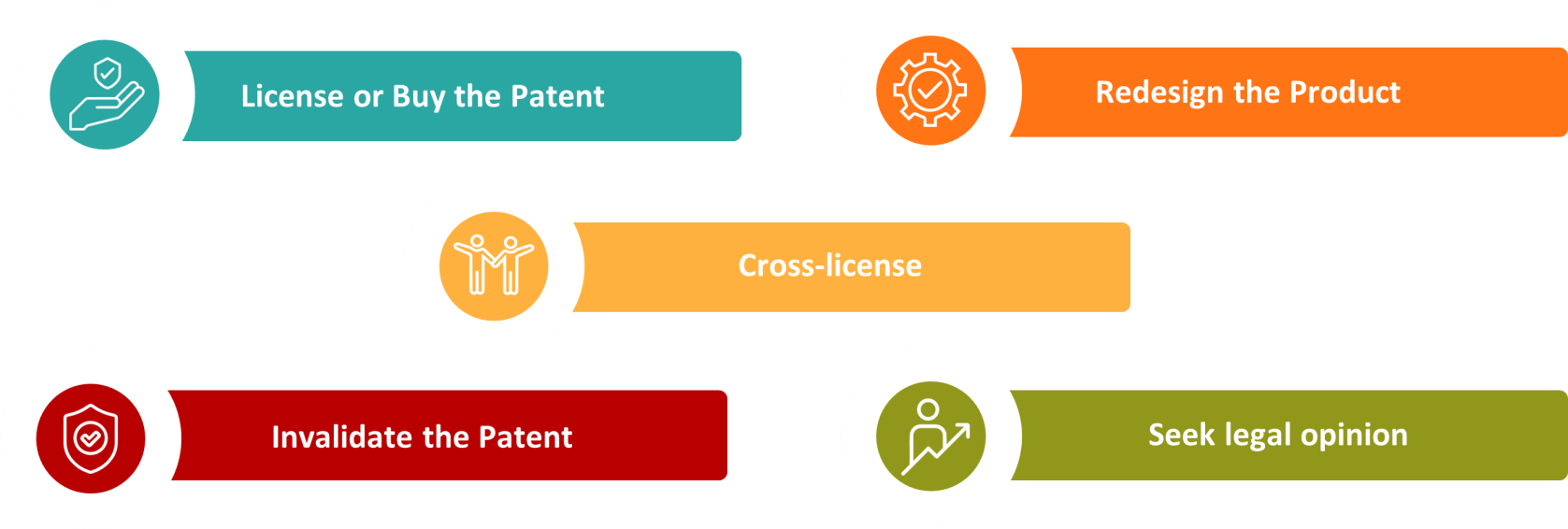1. What is Freedom to Operate?
Freedom to Operate (FTO) refers to your ability to develop, manufacture, and sell a product without infringing on someone else’s IP rights, most commonly patents. In industries like life sciences and engineering, where innovations are often protected by extensive patent portfolios, FTO is essential to avoid legal disputes that could halt product launches or result in significant financial losses.
Let’s say you’ve developed a new type of a glucose monitoring device. It’s new, innovative, and is ready to be launched in the US market. But before you decide to launch it, an important question arises:
“Can I sell this product in the US without infringing someone else’s patent or design rights?”
In this case, you can go for an FTO search to be sure that you will not infringe someone else’s rights once you launch your product in the market.
2. When to Conduct an FTO Search

3. Launching Without an FTO Search? Here's why that’s Risky

4. Best Practices during an FTO Search
1. Consider Both Granted Patents and Pending Applications
FTO search is typically limited to granted patents i.e., active patents, within the jurisdiction of interest as these pose a threat to the proposed product. Patent applications that are under examination should also be considered within the jurisdiction of interest, as once granted, the product may infringe these applications in the future.
2. Use Date restriction to Ensure Comprehensive Search Coverage
To mitigate the risk of overlooking relevant patents by applying filters on the database, applying date restriction may help. Patents usually have a term of protection for 20 years, by applying the date range of about previous 22-23 years will capture all results including those applications which were delayed for some reasons during examination.
3. Consider Post-Grant Modifications to Patent Claims
Post-grant claim amendments allow patentees to modify the claims after grant. These amendments can be made to clarify the invention, correct errors, or respond to challenges to the patent. This aspect should be carefully considered during an FTO search.
4. Focus on Relevant Jurisdictions
An FTO search is typically jurisdiction-specific, focusing on the regions where a product is intended to be launched. To ensure full coverage and reliability, the search should include regional patent databases of the relevant jurisdictions.
5. Verify the Legal Status of Patents
An FTO search helps evaluate whether launching a product or service in a specific market could infringe any third-party intellectual property rights. So, the legal status of potentially relevant patents should be verified using at least two patent databases, including regional databases, to avoid mistakes.
For WO/PCT applications, a period of the previous 31 months is considered.
5. Navigating an FTO Search: Step by Step

1. Identifying the key features and components of the product
Based on the disclosure of the invention or product, identify its novel features while understanding the product/invention in depth to build an effective search strategy.
2. Searching for patents and published patent applications
While searching for results, consider all possible logics, including relevant keywords and their synonyms, relevant classifications, top inventors, assignees, to ensure full coverage. Also, take jurisdiction and legal status into account.
3. Analysis of the selected references
The legal status of selected patents and published patent applications should be verified from the regional databases to reduce the risk of mapping a wrong reference.
The citation search and similar search of the selected references should be done to ensure that no relevant result is missed.
4. Mapping of the relevant results
A proper and detailed mapping of the relevant results is highly important, as sometimes a highly relevant result becomes useless if poorly mapped.
Proper detailed mapping should be done with relevant figures properly highlighted.
The results may be categorized into Tier 1, Tier 2, and Tier 3, based on relevancy and potential legal risk.
| Tier | Risk Level | Explanation |
|---|---|---|
| Tier 1 | High relevant | Claims cover or read closely on the product or process. |
| Tier 2 | Moderately relevant | Claims may be relevant, with additional elements. |
| Tier 3 | Low relevancy | Claims are unclear, not likely to cover the product or process. |
6. Some Critical mistakes to Watch Out For
1. Don’t Rely Solely on Patent Claims
Searching should not be solely focused on the patent claims, which is often a common practice. Sometimes, claims are structured in a more generic sense, and it may seem like the product or invention does not infringe the patent. However, additional details may be given in the specification to support the claims of the invention, and relying only on the claims is a frequent mistake that can expose you to unnecessary risks.
Non-patent literature (NPL) can reveal early-stage R&D that may later mature into patent filings, as a grace period is provided to the applicants during which they can publish blogs, papers, podcasts and videos. Monitoring authors or companies active in the field can uncover potential patent filings before they surface in official databases.
2. Thorough Review of the Entire Patent Specification
It is important to review the entire specification of patent applications, as the inventor or assignee may add more text from the specification to the claims. Further, they may file continuation or divisional applications of a parent application. In such cases, the specification content remains the same, but new claims can be added provided they are supported by the disclosure.
3. Filtering Patent Data: Helpful but Not Foolproof
Many patent searching databases provide different filters to ease the process of filtering out relevant data. Applying filters to sort active and published applications in databases can simplify analysis. However, in practice, these filters are often overly restrictive and may introduce unintended risks.
Patents that have lapsed due to unpaid maintenance fees may show legal status as “expired”, but they aren't necessarily dead. Most jurisdictions allow revival within a grace period after the fees and penalties are paid, and relying solely on these filters may result in missing relevant results.
7. Facing Blocking Patents? Here’s what to do

8. FTO Case Studies
Case Study 1:
Aim: To conduct a global FTO search for the use of a drug including its salts, analogs and derivatives for the treatment of a rare disease.
A thorough understanding of the drug structure and the disease was developed.
Methodology used:
1.The search began by covering all logics, including relevant keywords and their synonyms, as well as relevant classifications, along with date restrictions to capture active patents and patent applications.
2.To capture all relevant results, structure search was also conducted for the drug.
Since the structure had numerous possibilities as the client wanted the drug, including its salts, analogs, and derivatives, the following possibilities were covered:
- Exact structure search of the drug.
- Open structure search, where the ends in the chemical structure of the drug were kept open, i.e., with -CH3 and -H substitutions.
- Other substitutions were also applied in various permutations and combinations to cover all possibilities.
- Substructure and super structure search.
- Similar structure search.
- Searching including InChI, and Smiles.
3.Since it was a global FTO search, a wide range of patent databases were used, including paid, regional, and free databases.
4.Granted patents and patent applications claiming the drug's structure or name for treating the rare disease were shortlisted.
5.Mapping of the results was performed with proper highlighting of the structures.
Outcome: The client developed a patentable and commercially viable new drug for treating the rare disease.
Case Study 2:
Aim: To conduct an FTO search on a new type of an inhaler in the US.
Methodology used:
1. The search began by covering all logics, including relevant keywords and their synonyms, as well as relevant classifications, along with date restrictions to capture active patents and patent applications.
2.Rather than solely focusing on the components of the inhaler, the working mechanism of the inhaler was also considered.
3.Active patents and patent applications claiming the working, along with the same components, were shortlisted.
4.Similar search and citation search were also carried out so as not to miss any relevant results.
5.Detailed mapping of the results was done, with proper highlighting of the figures.
Outcome: As some blocking patents were discovered, the client successfully avoided infringement by modifying design and secured venture funding due to clear FTO.
9. Why FTO Should Be a Core Part of Your Launch Strategy
Freedom to Operate is more than a legal formality, it’s a critical safeguard when entering new markets or launching innovative products. Skipping an FTO search can lead to costly consequences, including wasted investments, product recalls, or legal disputes. When conducted properly, an FTO search does more than mitigate risk; it helps you to move forward with confidence, knowing your innovation is protected.
At Pitch Scientific, we offer end-to-end FTO search services to help you identify potential roadblocks, assess legal risks, and bring your products to market with clarity and certainty.
A well-executed FTO search is not just about avoiding legal trouble; it’s about securing your path to innovation. Let Pitch Scientific be your partner in navigating the IP landscape with precision, foresight, and integrity.